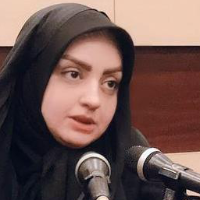Oral-Oriented Teaching of Meter through the Use of Music:Proposing a New Method of Teaching Meter in Poetry
The prosodic meter of poetry and rhythm of music both originate from the same source which is the symmetric sequence of sounds in time. Prosody seeks to understand various types of metric lines in poetry. Since the first tool for recognizing and understanding meter is through listening, it would be beneficial that teaching methods to be based on listening and speaking skills. However, teaching methods in most formal educational institutions focus more on the lingual aspects than musical ones. In traditional education methods, the participant should go through the labyrinth of learning traditional prosody to understand and memorize a piece. The difficulties of understanding prosody in classical approaches are rooted in onomastics and the categorization of Bohoor and Zahafat. The principles are not only obstructive but also confuse learners. Vaziri (1314, 1315), Khanlari (1386), Najafi (1391) consider the existence of Zahafat unnecessary and have put them all aside. They have smoothened the path of learning through regulating the exceptions, discretions, and necessities of poetry. According to the authors' experiences, there has not been a proper method for understanding meter and preserving that knowledge for a long-term. The method proposed in this study is the use of music to facilitate learning and long-term memorization of Persian poetry metric lines. This study aims at preventing the hardships and difficulties of learning prosody by updating the learning method and using musical content. With the proposed approach, two goals could be achieved: facilitating the learning while enjoying the process and empowering the long-term memorization of Persian metric lines. The first stage of this interdisciplinary study is gathering information from library and literature review. The next is some oral practices. The data procession method was descriptive-analytic. The results show that the educational musical content is necessary for teaching Persian poetry meter. The following order is followed in this paper: First, a summary of findings by other researchers on the effects of music on the brain and learning process and the role of music in teaching is presented. Second, by studying the sources in linguistics and definitions of the natural rhythm of speech, referring to Persian prosody and the theory of music, the constituents of music and prosody are adjusted. Then, the existing difficulties of naming the meters and classifications are analyzed to identify the issues regarding the process of learning prosody (which is the main purpose of this study). Finally, it has been shown that to produce a scientific content of musical learning, the characteristics of prosody should be considered. Knowing the principles of prosody and music is the main factor to offer ways for the use of music in prosody learning. In composing prosodic melodies, the musical rhythm and note durations are not choosable for the producer since these constituents are unconscious. To produce prosodic melodies, the producer has to choose three-note durations among 21 possible choices. These durations are the eighth note (e), quarter note (q), a dotted quarter note (j) that in the making of musical contents have identical relations with tri-syllable prosody (short, high, and long). Prosodic melodies are the same as Persian meters with syllables having bass capabilities in addition to prosodic ones (regarding duration and sentence structures) with the ability of intervals among durations that makes them capable of being a part of major and minor scales in addition to Iranian Dastgah such as Mahoor, Homayoon, Shoor. Learners can listen to the respective melody repetitively to learn and memorize a verse. By this approach, the prosodic meters are easier to understand without being forced to go through traditional rules. Through studying the sources on traditional prosody and fundamental issues of Bohoor, and new sources on this matter which consider Zahafat unnecessary or even wrong, it could be concluded that learning prosody adds nothing but understanding the forms. In new prosody, understanding the rules of syllable scanning all depend on understanding the meter first. Learning the meter can be facilitated by using it in repetitive sessions of listening. This practice does not require any professional skill. The results of this study show that prosody contains a few parts of the musical capabilities. That is, all such capabilities are available in the theory of music. As a result, it is possible to modernize all the rules of Persian poetry through rhythm. Besides, the data provided by this research paves the way for creating educational musical contents with melodic prosody to facilitate learning and long-term memorization of Persian poetry meter.
- حق عضویت دریافتی صرف حمایت از نشریات عضو و نگهداری، تکمیل و توسعه مگیران میشود.
- پرداخت حق اشتراک و دانلود مقالات اجازه بازنشر آن در سایر رسانههای چاپی و دیجیتال را به کاربر نمیدهد.


